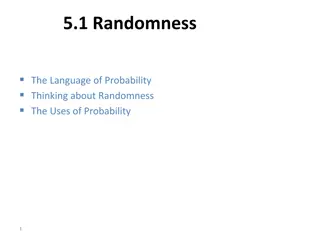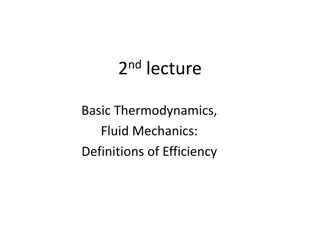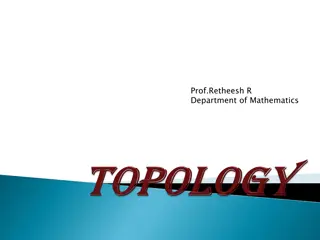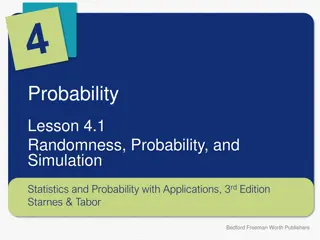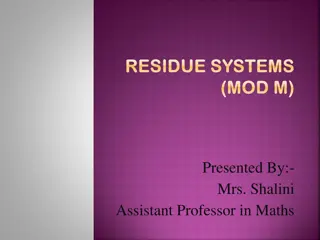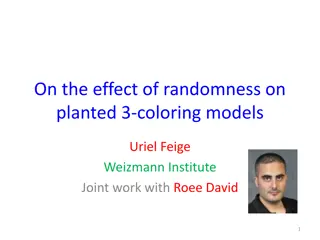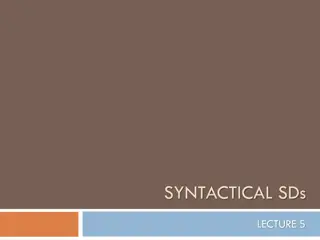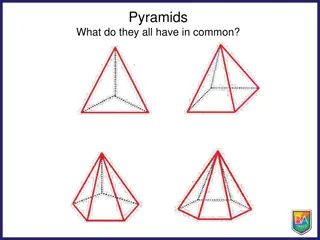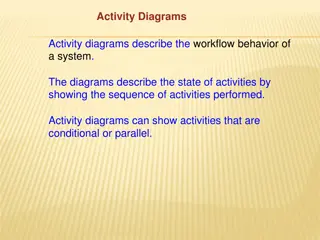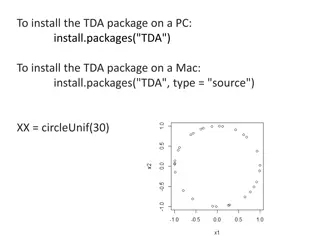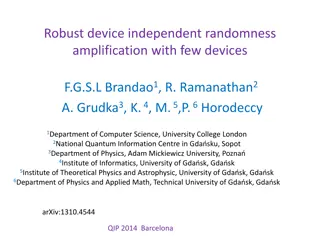Randomness in Topology: Persistence Diagrams, Euler Characteristics, and Möbius Inversion
Exploring the concept of randomness in topology, this work delves into the fascinating realms of persistence diagrams, Euler characteristics, and Möbius inversion. Jointly presented with Amit Patel, the study uncovers the vast generalization of Möbius inversion as a principle of inclusion-exclusion, touching upon historical figures like August Ferdinand Möbius and innovative combinatorial theories. The visual representations provide a deeper understanding of posets, Möbius functions, examples of inclusion-exclusion, and Möbius inversion applications in persistence diagrams.
Download Presentation

Please find below an Image/Link to download the presentation.
The content on the website is provided AS IS for your information and personal use only. It may not be sold, licensed, or shared on other websites without obtaining consent from the author.If you encounter any issues during the download, it is possible that the publisher has removed the file from their server.
You are allowed to download the files provided on this website for personal or commercial use, subject to the condition that they are used lawfully. All files are the property of their respective owners.
The content on the website is provided AS IS for your information and personal use only. It may not be sold, licensed, or shared on other websites without obtaining consent from the author.
E N D
Presentation Transcript
PERSISTENCE DIAGRAMS, EULER CHARACTERISTICS, & M BIUS INVERSION Primoz Skraba Randomness in Topology & Its Applications March 21, 2023
Outline Joint work with Amit Patel
Outline M bius inversion Euler Persistence diagrams characteristic
Mbius Inversion M bius inversion is a vast generalization of the principle of inclusion-exclusion.
Mbius Inversion M bius inversion is a vast generalization of the principle of inclusion-exclusion. August Ferdinand M bius 1832 Euler s Totient Function 1763 Notation from Gauss 1801 Gian-Carlo Rota 1964 On the foundations of combinatorial theory I
Posets Notation:
Posets Notation:
Mbius Function Example:
Mbius Inversion Example:
MBIUS INVERSION PERSISTENCEDIAGRAMS
Persistence Diagrams Classical Persistence:
Posets of Intervals Elements: set of all intervals, Ordering: two possibilities (Inclusion ordering) (Product ordering)
PD as Mbius Inversion 2007: Cohen-Steiner, Edelsbrunner, Harer 2016: Patel Inclusion ordering
PD as Mbius Inversion 2007: Cohen-Steiner, Edelsbrunner, Harer 2016: Patel Inclusion ordering
PD as Mbius Inversion 2007: Cohen-Steiner, Edelsbrunner, Harer 2016: Patel Inclusion ordering
PD as Mbius Inversion 2007: Cohen-Steiner, Edelsbrunner, Harer 2016: Patel Inclusion ordering
PD as Mbius Inversion 2007: Cohen-Steiner, Edelsbrunner, Harer 2016: Patel Inclusion ordering
PD as Mbius Inversion 2007: Cohen-Steiner, Edelsbrunner, Harer 2016: Patel Inclusion ordering
Multiparameter Persistence Works over any poset Generalized rank invariant, fibered barcode, etc.
Birth-Death Function 2016: Henselman-Petrusek, Ghrist 2022: McCleary, Patel Product ordering
Birth-Death Function 2016: Henselman-Petrusek, Ghrist 2022: McCleary, Patel Product ordering
Birth-Death Function 2016: Henselman-Petrusek, Ghrist 2022: McCleary, Patel Product ordering
Kernel Function Product ordering 2022: G len, McCleary
Kernel Function Product ordering 2022: G len, McCleary
Equivalence 2022: G len, McCleary Birth-Death Function Same Persistence Diagram (up to the diagonal) Kernel Function
Applications Bottleneck Stability rank function Duy, Hiraoka, Shirai: Limit Theorems for Persistence Diagrams birth-death function Appearance: Proof of convergence
Applications Bottleneck Stability rank function Duy, Hiraoka, Shirai: Limit Theorems for Persistence Diagrams birth-death function Appearance: Proof of convergence Exploit monotonicity of birth-death function
MBIUS FUNCTION EULER CHARACTERISTIC
Euler Characteristic Theorem [Hall 1928 Rota 1964]
Related Work Reference Stanley, Enumerative combinatorics, Vol. 1 Wachs, Poset Topology: Tools and Applications Highlights Rota, Folkman, ivaljevi , Ziegler, Kozlov, Walker, Stanley, Crapo, Bj rner,
PERSISTENCE DIAGRAMS EULER CHARACTERISTICS
Modules over Posets Recall: Module
Modules over Posets Recall: What is the M bius inversion of a vector space? Patel 2016
Back to Topology (Simplicial) Cosheaf
Rota Cosheaf Example: Rule:
Mbius Inversion as EC Theorem
Mbius Inversion as EC Theorem
Key Idea Hall s Theorem [1928]
Cosheaf Homology Rather than the Euler characteristic, we can take the homology groups
Cosheaf Homology Rather than the Euler characteristic, we can take the homology groups
2D Example Does considering homology help? *Example due to Vidit Nanda
Rotas Galois Connection Theorem Theorem [Rota, G len-McCleary]


